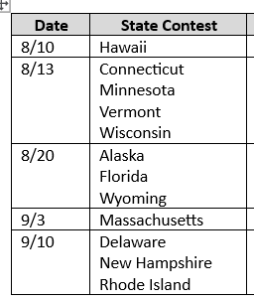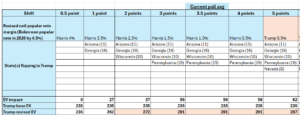Introduction
The Olympics (which concludes tomorrow) are coming to a close, and the Democratic convention in Chicago commences in 9 days. The Democrats finally have their ticket determined, as Kamala Harris chose Minnesota Governor Tim Walz as her running mate.
On the Congressional/statewide primary circuit, four more states (Kansas, Michigan, Missouri, and Washington) held their primaries this past Tuesday, and Hawaii’s primary is today. That leaves us with 13 more states that have not yet held their primaries. This “primary-a-thon” continues on Tuesday, with Connecticut, Minnesota, Vermont, and Wisconsin, and will last until September 10 (Louisiana’s primary coincides with the Federal Election Day of November 5).
With Labor Day just over three weeks away, what has been going on (from a polling perspective) with the Presidential race?
Presidential polling
When discussing polling for the 2024 Presidential contest, there are two atmospheric challenges the party in power/its nominee Kamala Harris faces: (1) while improving, her approval ratings remain “underwater” (her 43-49% approval/disapproval according to 538 is almost identical to what it was last week), and (2) persistent high disapproval (43-54% approval/disapproval according to a 7 day average of polls taken) for the Biden administration. Since Kamala Harris is still Joe Biden’s Vice-President, that persistent disapproval is something that is a negative weight on her campaign.
Still, the Harris campaign has benefitted now from a three-week honeymoon that has involved both a smoothly executed rollout of her campaign and a leak-free Vice Presidential selection process. On the Republican side, the Trump/Vance ticket hasn’t yet figured out how to turn their poll numbers around, and for the first time, the Harris/Walz ticket has moved into the lead from a 7 day average of national polling with a 1.1% lead.
From a numerical/trend perspective, a 3.2% Trump poll lead three weeks ago is now a 1.1% poll deficit (a 4.3% unfavorable movement, in other words). If current trends were to continue, Harris would be up two points in the national polls by the time the Democrats convene in Chicago on August 19, and since convention news coverage that week likely will give the Democrats another “good week”, Donald Trump could theoretically be 4-5% down in the polls by the time Labor Day (the traditional kickoff for the final sprint of the Presidential campaign) rolls around. Below is a representation of the weekly changes in the national poll averages:
It’s also important (in terms of putting the poll numbers in their proper context) to realize that the Electoral College (and not the national popular vote) is what actually elects a President, and that distinction presently benefits the Republicans. Since there is an inefficient vote distribution of Democratic and Republican votes, it’s possible for a Republican to be elected President without attaining a popular vote majority (or even a plurality), because California and New York have in recent election cycles generated larger Democratic vote margins than Florida and Texas have for Republicans.
National popular vote vs the Electoral College
Even though Joe Biden was elected in 2020 with a 4.5% popular vote margin (51.3-46.8% over Donald Trump) and a 303-235 lead in the Electoral College using applicable numbers for the 2024 Presidential election (270 electoral votes are needed to win), Biden’s Electoral College victory due to narrow victories in several states, like Arizona, Georgia, Michigan, Nevada, Pennsylvania, and Wisconsin.
From that starting point of a 4.5% national popular vote win, we can assess the extent to which shifts in the national popular vote towards Trump could flip specific states, as national shifts do have an impact in both swing and non-swing states. To be conservative in his analysis, JMC is assuming that only half of a national popular vote shift (percentage-wise) would occur in a swing state, since those states (which get an oversized amount of attention from either side) tend to be less elastic in their movement towards a candidate.
Even with this conservative analysis, any movement towards Trump relative to a 4.5% national popular vote deficit would still have an electoral impact in that states that narrowly voted for Biden in 2020 would “flip” to Trump. For example, even a Kamala Harris national popular vote win of 3.5% (a shift of 1% towards Trump, in other words) would flip Arizona and Georgia, which would then put Trump up to 262 electoral votes (8 electoral votes shy of a victory, in other words). A Harris win of 2.5% (a 2% shift towards Trump relative to 2020) would also flip Wisconsin and get Trump to the necessary 270 electoral votes.
The last seven days of national polling shows an average lead for Kamala Harris of 1.1% (she’s up 46.7-45.6% over Trump), which would translate to 291 electoral votes for Trump. In other words, a 1.1% Harris lead equals a 3.4% swing to Trump relative to his 2020 popular vote loss. A swing of that magnitude (even accounting for swing states’ being less elastic than the rest of the country) would flip Arizona, Georgia, Pennsylvania, and Wisconsin and give Trump the electoral votes he needs to win. Below is a representation of the electoral college impact of various national popular vote possibilities.
Conclusion
Even though the last three weeks have not been good for Republicans, at some point, the record of/prior statements made by Kamala Harris will be subject to more scrutiny, and that scrutiny will have some sort of electoral impact, as will candidate debates. What is crucial for Republicans is to define her while avoiding making controversial remarks (such as any discussion about her race) that turn off swing voters, because further erosion in their lead will cost them their narrow lead in the Electoral College. This posting was meant as a visual illustration of how national polling numbers would translate to various Electoral College vote possibilities.



